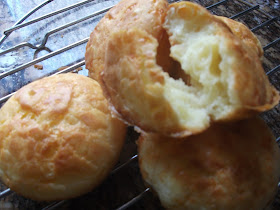I have to make a confession. I have tried many times to make decent bread using spelt flour... and failed. I know that spelt has less gluten, much less gluten, than regular wheat flour. I also know that, aside from being quite trendy it is very healthy for you. And super tasty. So, I decided to try once again. But with a twist. I decided to compensate for the lack of gluten by adding some. And I also gave the bread a flavor boost by adding a mixture of flours. This bread, with my own combination of whole wheat, rye and spelt flours is super delicious and even 'safe' for vegans. By that I mean, it includes only the basic four ingredients needed for bread: flour(s), water, yeast and salt. Oh, and the added gluten. No eggs or honey. So try this and let me know what you think. It rises slowly but is well worth the effort.
Here's What You'll Need (for one large loaf - about 2 lbs (1 kg.):
2 cups whole wheat flour
1 cup whole rye flour
1 cup whole spelt flour
2 Tbs. instant dry yeast
about 2 cups water
2 Tbs. gluten
1 1/2 tsp. salt
2 Tbs. sugar (brown sugar optional)
Here's What You'll Need To Do:
1. Mix the flours and the yeast evenly in a large bowl. Add the sugar, salt and gluten and mix thoroughly.
2. Add the water gradually, mixing by hand, until you have a soft fairly sticky dough. Work slowly as the whole grains need time to fully absorb the water. When all the water is absorbed, cover and let the dough rest for about 20 minutes. This is the autolyse, sort of. A true autolyse would be without the yeast.
3. Remove the dough to a lightly floured surface, and knead, with stretching and folding, to develop the gluten. After a few minutes the dough will come together and become less sticky and more elastic.
4. Place the dough in a lightly oiled bowl, cover, and let it rise until doubled in volume, about two hours. This bread will rise slowly, even with the added gluten so don't be surprised if it takes a while.
5. Remove the dough from the bowl. Gently shape it into a loaf form, and place it in a 9 X 5 (23 cm X 13 cm) loaf pan that is lightly oiled. Let it rise, covered, until it is just higher than the edge of the pan.
6. About 20 minutes before the end of the rise, preheat the oven to 375 F (190 C). Bake the bread for about 35 minutes or until it sounds hollow when tapped on the bottom. Cool on a rack completely before slicing.
7. Enjoy!!












